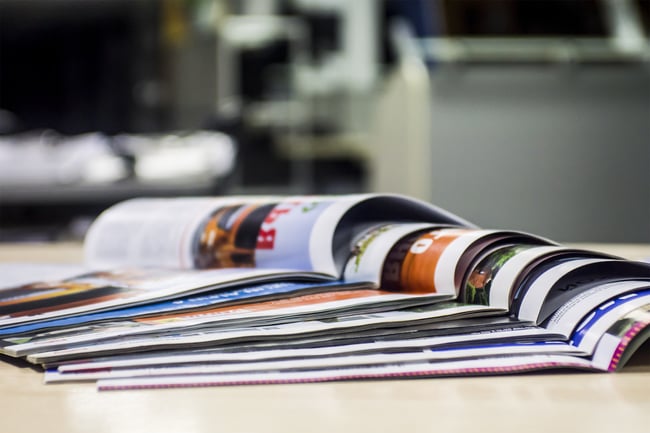PRODUCTION PRINTING | 4.5 MIN READ
Are you a company that frequently changes its forms, prints mass invoices, or tax returns? Do customer catalogs, sales or marketing materials change frequently? If so, considering a production print system is a good idea. Examining your needs and qualifying the value of switching is easier than it sounds. Keep reading to learn what a production printer is and how to tell if it's a right fit for your business.
Not enough time? Jump to:
What is Production Printing?
Production print machines are used for high-volume printing of manuals, pamphlets, posters, and more. Generally, print jobs move from standard to production printing at around 110+ ppm (pages per minute) for black and white and 70 ppm for color.
Who Uses It?
Typically, these printers are geared towards design and print shops because of the sheer volume of print jobs they produce on a day-to-day basis. However, other industries find these machines useful too.
Marketing agencies and sales teams use these machines to print brochures, catalogs, and more. They need a machine that can quickly produce a large amount of color-critical and high quality materials for marketing/sales collateral.
Industries that situationally have large print jobs, for instance many copies of forms or lengthy reports, may benefit from production printers as well.
These types of businesses most likely need a system that can efficiently print up to 250 pages per minute. Companies with this need may prioritize speed over color-matching and detail quality.
For example, while churches may not use printers that often, once a week before Sunday service, they may quickly need to churn out thousands of copies of that week's bulletin.
Add in any monthly newsletters or event flyers that are needed and then churches become less of an unlikely candidate for production printers.
Is It Right for You?

Keep reading to learn some points you should keep in mind when deciding if a production printer is the best fit for your business.
Service
When you buy or lease a copier or printer, service should always be factored into the total cost, seeing as machines have a tendency to break down over time.
If you buy a printer, for instance, service may not be included in the price, which means that if you bought the machine on sale, it may end up costing more in service fees.
Copier service pricing can vary widely from dealer to dealer, and even wider from dealer to manufacturer. This means that you should do your math carefully when buying/leasing a printer and determining service costs.
What causes service pricing to be expensive?
The big difference in service pricing occurs when comparing different machines. It's very possible for smaller, cheaper machines to ultimately cost more than larger and more expensive ones. When you compare the service cost of one machine to another, you have to factor in a machine's efficiency.
Smaller machines break more often, causing higher service costs. Dealers typically include service with the per-print costs, but your per-print cost will often be higher with a less efficient machine because the vendor knows that it's going to need service more often.
The difference in service costs can be several hundred dollars more per month, per machine. Older or used copier machines can also have higher service costs, but there may be significant savings on the equipment purchase.
Besides a printer's age, another way to tell how used a machine is is based on how many print jobs have been made on it. Copiers are like cars- high copies are the equivalent of high mileage.
When determining service costs for a production printer, do your research on what an appropriate number of copies is for that model based on the year it was built.
RELATED: Copier Dealers vs. Manufacturers: 3 Myths Busted
Cost-Effectiveness

A single production print machine can run $50,000 to $1,000,000+ if it is purchased outright. The price tag alone will turn away some companies because they don't print enough material to warrant a higher-end printer.
While it may seem wasteful for organizations who have infrequent large print jobs to spend money on a production printer, the reality is that smaller multi-function printers aren’t built to handle that kind of volume in infrequent spurts.
The inefficiency you get with these printers requires more frequent toner replacement, which can lead to higher service rates.
While some businesses may think that the cost of a production printer doesn't warrant its purchase, they must also consider how much they spend on out-of-house print jobs.
For instance, if you are a business or organization that does its printing through an external party, then items such as marketing and sales collateral, posters, etc. can often become additional waste.
Companies tend to order a surplus of copies which leads to inevitably wasted leftovers, especially when those copies become outdated and useless. The cost of wasted surplus copies as well as overpriced out-of-house print jobs done through a printing company can quickly add up.
By moving to an in-house solution, you have the freedom to print only what you need without the extra costs that printing companies charge.
The functionality of what you can do is also improved. For instance, most standard MFP’s cannot do full bleed printing, whereas some production systems can more closely give you the look you desire.
Finishing equipment, such as folders, come standard on many models, as well as binding options (perfect for when you need large quantities and high-efficiency).
How do I know if my company would save money with a production printer?
As a simple exercise, sit down and list all the areas in which you could save by switching. This should include more than the superficial and obvious answers (like service costs because your small printer fleet is too big, or because you do not have to pay for mark-ups when using a third-party).
An easy way to determine if your print volume warrants the purchase of a production printer is your print volume with your current machine fleet.
If you have smaller multi-function printers and also have a consistent need for printing higher volumes, then you may be a candidate for a switch and should reach out to a local copier dealer to learn more.
This exercise could point toward a new opportunity for your organization to increase its margins and/or efficiency. You may find yourself wishing you had switched a long time ago, as the cheaper option you are using now may not actually be the most cost-effective.
Production printers aren't the right fit for every business. Some may benefit from a fleet of multi-function printers or even no printers at all.
We hope that this article answered your questions. For more printer-related content, follow our blog!
Posted by SOS Can Help
Standard Office Systems prides itself on consistently creating value for its clients with our unparalleled customer service. We not only achieve, but exceed industry standards & client expectations with our true in-house leasing, on-site Network Operations Center (NOC), client response time, and first-call fix-rate in Atlanta, GA and nationally.


